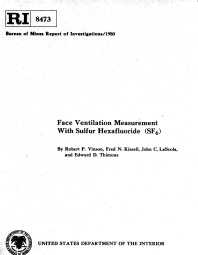Mining Publication: Face Ventilation Measurement with Sulfur Hexafluoride (SF6)
Original creation date: January 1980
The face ventilation measurement method developed by the Bureau of Mines involves releasing a small volume of tracer gas (SF6) on the off-curtain side of the working face at the start of the mining cycle. At the same time, gas bottle samples are taken in the immediate return airway. The gas samples are analyzed, and a curve is drawn of sf6 concentration versus time. From this curve, the percentage of gas removed per time is calculated. A curve showing a high percentage of the tracer gas removed in a short period would represent a well-ventilated face. The face ventilation measurement method was tested in a full-scale mine entry model. Subsequently it was used underground to evaluate the spray-fan ventilation system and in an MSHA test facility to test machine-mounted scrubbers. The method was shown to be a simple and effective way of evaluating face ventilation systems.
Authors: RP Vinson, FN Kissell, JC LaScola, ED Thimons
Report of Investigations - January 1980
NIOSHTIC2 Number: 10002527
Pittsburgh, PA: U.S. Department of the Interior, Bureau of Mines, RI 8473, 1980 Jan; :1-16
See Also
- Coal-Mine Ventilation Factors
- Development of Coal Mine Face Ventilation Systems During the 20th Century
- The Effects of Water Spray Placement for Controlling Respirable Dust and Face Methane Concentrations
- Impact of Unbalanced Intake and Scrubber Flows on Face Methane Concentrations
- Mine Face Ventilation: A Comparison of CFD Results Against Benchmark Experiments for the CFD Code Validation
- Sulfur Hexafluoride as a Mine Ventilation Research Tool - Recent Field Applications
- Technology News 430 - Translucent Face Partition Reduces Longwall Worker's Dust Exposure
- Using Sulfur Hexafluoride as a Gaseous Tracer to Study Ventilation Systems in Mines
- Using Ultrasonic Anemometers to Evaluate Face Ventilation Conditions
- Using Ultrasonic Anemometers to Evaluate Factors Affecting Face Ventilation Effectiveness
- Content source: National Institute for Occupational Safety and Health, Mining Program


 ShareCompartir
ShareCompartir
